Pioneer in Champagne in biodynamic farming, the Fleury family who follows the rhythm of nature the equinoxes unfolds crescendo a range of new cuvees with a vibrant acidity for connoisseurs.
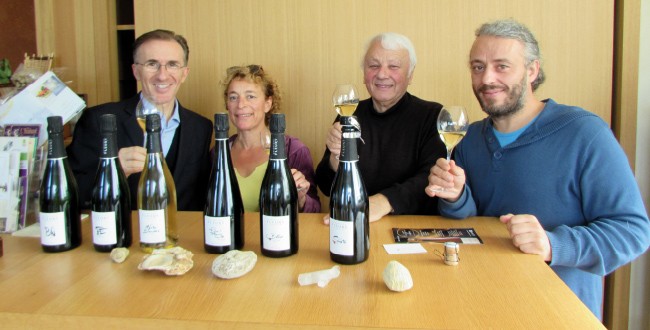
The conductor is the father Jean-Pierre Fleury. As from 1989, as a forerunner, he converted three hectares into biodynamics then the whole Fleury vineyard in 1992, i.e. 15 hectares in the Côte des Bar area, not far from their stronghold in Courteron. In the orchestra the current managers, a fantastic trio: the Fleury children with Benoit in the vineyard, Jean-Sebastien for the vinification and Morgane trained sommelier who is in charge of the shop in Paris. Their instruments? Famous varieties with the Pinot Noir that represents 85% of their production and that sets the tone to their last cuvee, a 2006 extra brut 100% Pinot Noir with notes of mirabelle brandy, kirsch, melon and plums with the lovely name of “Bolero”.
Another piece of art of their range: “Notes blanches” 2011 Brut Nature, a confidential cuvee, aged in oak barrels and 100% Pinot Blanc, a more unusual variety that, according to Best Sommelier of the World Paolo Basos, opens up “with density and powerfulness”. “But we have also created a lovely blend of Pinot Noir and Chardonnay in the extra brut 'Sonate'” explains Jean-Sébastien Fleury who precises that this musical name is inspired by the “light and varied emotions provided by this Champagne and by our wish to let the nature and its rhythms express” while respecting all the stages from the blooming to the fermentation and the ageing.
It has to be recognized that the Fleurys through the years have become masters of biodynamic farming: natural compost, mechanical weeding, spraying of quartz silica early in the morning to intensify photosynthesis and, for the 5 last years, tests with anti-mildiou teas with copper sulfate, sulphur, nettles … “The life path of four generations” says Jean-Pierre showing the box containing his grandfather Robert's notebooks, genuine treasures with all the weather informations and evolution of their vineyard day after day.
A rare example in Champagne.“We are only some to practice biodynamics in Champagne and some thirty working organically with a production of only 1 million bottles out of the total 300 million. There are still a lot of economic and psychological barriers, the Champagne wine growers, with higher yields than in other regions and healthy markets, do not see the advantage of converting”, states Jean-Sébastien who is happy he convinced a few his neighbours.
Starred restaurants–Sola in Paris, Elsa in Monaco, Les Crayères in Reims …–Fleury's customers make no mistake and have chosen these eco-friendly cuvees, whose acidity is strengthened by biodynamics, and dedicated, according to Paolo Basso, to be enjoyed by a public of “well-informed connoisseurs”.
At Balnot-sur-Laignes, at the heart of the Aube department, the Gremillet family house cultivates its difference in the Champagne universe with its creative spirit and very expressive cuvees.
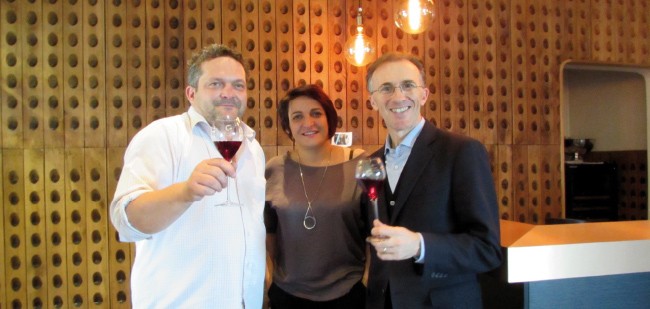
A modern building on the top of a hill striped the rows of vines. A breathtaking landscape. The visit is guided by Anne Gremillet, “the house's girl” and starts with Clos Rocher, created in 2012: 1.4 ha planted with Pinot Noir closed with walls and wrought iron. “This Clos, something quite rare in Champagne, was my father Jean-Michel Gremillet's dream. The conclusion of a swift development of the house that grows from the 3,500 sqm inherited from my grandmother in 1979 to the 42 hectares nowadays”, explains Anne who doesn't hide her pride. Then she takes us to a round little house in the middle of the vineyard where are organized the tastings or gastronomic lunches. A bit further, the reception room that can host 120 harvesters every year. These days only a few houses preserve this convivial aspect of the harvest.
After Clos Rocher, a lovely botanical garden opens its doors to us to tell us a peculiar story: the 82 trees that are planted here are all native from the country they represent. They tell, tree after tree, how Jean-Michel Gremillet managed to stand out, when he still was a little producer, on one of the most prestigious niche markets: the French embassies and consulates abroad. “And it still is a current market in some forty embassies” Anne ads. “We also have an original partnership in Guyana where every successful rocket launch is celebrated with a bottle of Gremillet.”
However the house gains more and more shares on the French market thanks to the development of wine tourism and its presence on the trade fairs in France. A loyal clientele that loves their cuvees: Brut Sélection representing 60% of their sales with its aromas of white blossom and tropical fruits and a generous dosage; more elegant, Brut Blanc de Blancs, “a beautiful expressive and fine Champagne” according to Best Sommelier of the world Paolo Basso. But also, particularly well-structured, firm and masculine, Brut Blanc de Noirs, that aged 36 months on the laths, perfect “over intense fish dishes and poultry like fattened chicken or guinea fowl”.
Indeed Jean-Christophe Gremillet, Anne's brother, who works on the blends and the vinification, is very creative in improving his cuvees. His Champagnes stem exclusively from the first pressing and their maturing times are longer than the standards, with 22 months from the non-vintage Brut and up to 5 years for the vintage Champagne. And in addition, a very special care to avoid oxidation thanks to their “jetting” technique.
A truly original family house until the end of the bubbles. It claims its youth and swift construction, nurtures optimism and work because “all your successes deserve a Gremillet” as says the house's slogan.
Established in 1808, the Henriot house managed to keep for eight generations traditional cuvees exuding aromas of citrus and pastry. In Reims we met Laurent Fresnet, the cellar master since 2006, always ready to “share a bubbley” and who rigourously and smoothly ensures continued existence to the Henriot style.
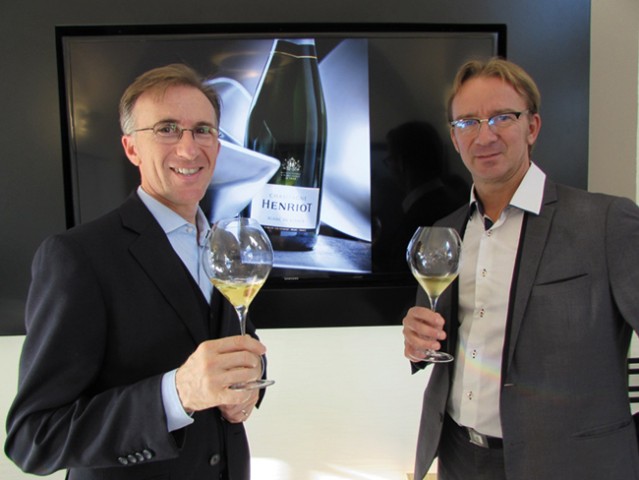
How would you define the Henriot house's DNA?
A majority of Chardonnay and two thirds of First and Grand Crus, i.e. rich wines aiming at providing finesse and minerality. Our philosophy is also to guarantee a consistent quality of the production and keeping in mind the search for minerality, freshness with aromas of citrus and with a pastry, brioche and creamy side.
Where do you source the grapes, especially the Chardonnay, the variety favoured by your house?
We run 35 ha, 50% Chardonnay and 50% Pinot Noir. The Chardonnay mainly stems from limestone soils in the Côte des Blancs area and the Pinot Noir from the Mountain of Reims near Epernay. To that are added 120 ha of supply, mainly in the 42 First Crus and the 17 Grand Crus of the appellation, among them Chouilly, Oger, Avize, Mesnil, Vertus for the Chardonnay and Verzy, Verzenay, Avenay, Mareuil, Mailly for the Pinot Noir.
What are your best sellers?
We produce 1,6 million bottles a year exported by 40%, especially to the United Sates, Japan, Italy … Our reference brand “Brut Souverain” represents nearly 70% of the sales; it consists of 50% Chardonnay for the freshness and the finesse and approx. 45% of Pinot Noir that gives a citrusy side, a crisp feeling, and 5-8 % of Meunier according to the years. It contains 30% of reserve wines out of which half from the previous year and the other half from older years. It is one of the specificities of our blends and the key of the consistency of our Champagnes. And our secret, the Perpetual Reserve Vat 38.
What is the peculiarity of this Vat 38?
It consists of only Chardonnay (4 Grand Cru villages in the Côte des Blancs area) from 30 harvests in the current version. Refreshed by 15% every year, this reserve used in all our NV Brut Champagnes. This vat was meant to represent the style, the DNA of the house for the NV bruts. But in 2009, we decided to bottle a small quantity in magnums (3% of the volume of the vat).
A freshness you also sought when crafting your “treasure”, the Blanc de Blancs?
Made with Chardonnay for First and Grand Crus by 80%, aged 5 years, our Blanc de Blancs contains 40% of reserve wines and, de facto, is dosed by only 7g which creates a citrusy feeling, a white peach side in the nose which will turn into nectarin over time. People think the Blanc de Blancs can have a 'green' character, but in fact our Blanc de Blancs is generous and is marked by a pastry side.
In the end of 2017, you have also released a Brut vintage 2005 in magnum. How would you describe it?
Made in equal parts with Chardonnay and Pinot Noir only stemming from First and Grand Crus, added with home-made liqueur, this wine aged and matured for 10 years. The palate is well-balanced with aromas of citrus, especially candied. The nectarin and yellow-fleshed peach dominate, then comes the smoothness of the fresh butter. It is a very fruity and generous wine.
Since its purchase in 2006, the reputation of Lanson took a new impetus. Refurbished with brand new equipment, it multiplies cuvees of prestige to sublimate the Grand Crus, finesse and freshness of its Champagnes.

Something rare, one hectare of Chardonnay in the middle of Reims, an island of greenery overhanging buildings and houses, and in the horizon, the towers of the majestic cathedral. A jewel that, thanks to Lanson chairman Philippe Baijot’s will, very attached to this plot, has become in 2016 a clos. “This pure Chardonnay planted in 1962 has given the first Clos Lanson vintage in 2006” proudly announces cellar master Hervé Dantan. “This exceptional plot is located on the top of a hill, with a very crumbly chalk and very dry soils. If you combine the fact that is surrounded with walls with higher temperatures–which means early harvest–you get very special Chardonnays, very ripe and generous with a lot of aromas, precision, saltiness as the limestone is very present”, he specifies to Best Sommelier of the World Paolo Basso who appreciates “the lovely crystal-clear robe and the intense nose with aromas of yeast, green pepper and white blossom” of the Clos Lanson Blanc de Blancs 2006, not declared extra brut but with a discreet dosage of only 3 g.
Selective and prestigious this vintage is a kind of symbol of the turn taken by Lanson to gain excellence since it was purchased by the three Paillard, Baijot and Roques-Boizel families. “A youthful boost that I was lucky to participate in”, says Hervé Dantan who succeed cellar master Jean-Paul Gandon in 2013, while introducing to Paolo Basso the new vathouse just alongside the clos, with brand new vats of 40 to 100 hl that all bear the names of the different terroirs. “To gain quality, we now work with micro-plot selection, and since 2013 we also have a new cellar with 23 oak tuns for the ageing of the reserve wines. The house’s signature is also not to use malolactic fermentation, it is what makes our identity. We block the malolactic fermentation by the cold at 8°C. Thus the wooden tuns provide a lot of aromatic diversity and creaminess, they enable to enrich the style while keeping the fruitiness, freshness and elegance”.
De facto, in the range of thirteen different Champagnes, Paolo Basso enjoyed, among others, savoury Blanc de Blancs “Noble”, with exceptional bruts in the vintages 1989, 1990, 1997 and 2002, qualified “excellent” by the sommelier who evokes “a beautiful wine that seduces by its strength and its brightness, and can accompany fish with unctuous sauces that will balance the freshness”.
In order to reach excellence the Roederer house uses the very essence of the best terroirs of Champagne to compose Cristal, but the research goes further. Its increasing conversion to organic and biodynamic farming combined with top-notch technologies propel it to the top. We met Jean-Baptiste Lécaillon, cellar master since 1999, pillar of the house for thirty years, who manages to combine ideals and pragmatism.
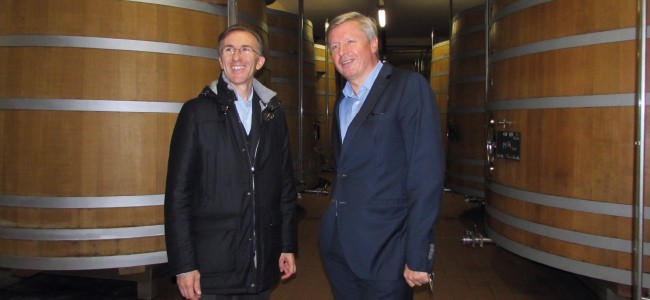
Since the middle of the 90s a huge work has been undertaken by Roederer to give back typicality to its Champagnes. Where do you stand today?
In 1996 the decision has indeed been taken to avoid standardization by finding the identity of each plot of land, and to adapt the vinification to each of them, reintroduce ploughing, stop insecticides, make our own compost, etc. The result is that in 2017, 140 ha are grown organically and 100 ha use biodynamics. The goal is to convert into 100% biodynamics for Cristal by 2020. According to us, a better respected soil simply better expresses the spirit of the place. My ideal has always been to tend to permaculture. If you want the wine to have the taste of the place, I think the best is to intervene the less possible. However in Champagne, it is not possible because of the dispersal of the plots of land in the landscape, whereas permaculture can only be considered for an entire ecosystem. Having said that, my first goal is to make a delicious wine, not absolutely in biodynamics. If the vineyard is threatened we will not use biodynamics.
In the vinification process what changes have you made?
To make the wines more powerful and rounder, we chose to mature them in large oak tanks in order to seek oxygen–more than woodiness by the way. To me Champagne is one of the most human wines and requires a strong human intervention. The most crucial point is during the first fermentation and the mineralization phenomenon that comes with the effect of yeasts, by playing with oxidation and fermentation. During prise de mousse, we favour soft pressure–4 to 5 bars instead of the usual 6 in Champagne. The finest the mousse is, the creamier it becomes and the less we feel the carbonic gas. To Roederer, Champagne must be a caress. Our cellars are also equipped with UV-free lights to avoid the metallic and sulphur taste in the wines. A research also resulted in the design in 2006 of a brown glass bottle that filters the UV rays by 98%, i.e. 6 points better than green glass.
According to you, what has been the greatest technological progress in the last years that enabled you to improve vinification?
To me, the infrared spectroscopy FTIR is a significant progress. In less than a minute we get an incredible amount of information about the sugar content, acids, CO2 …, which is precious to decide in what extent we should intervene, to confirm or not what we previously used to analyze empirically.
In the whirlwind of youth and seduction, parties into the night and movie stars … though established in 1785, Piper-Heidsieck moves with the times. With a turn, in the early 21st century, to give its cuvees an extra touch of soul and personality.
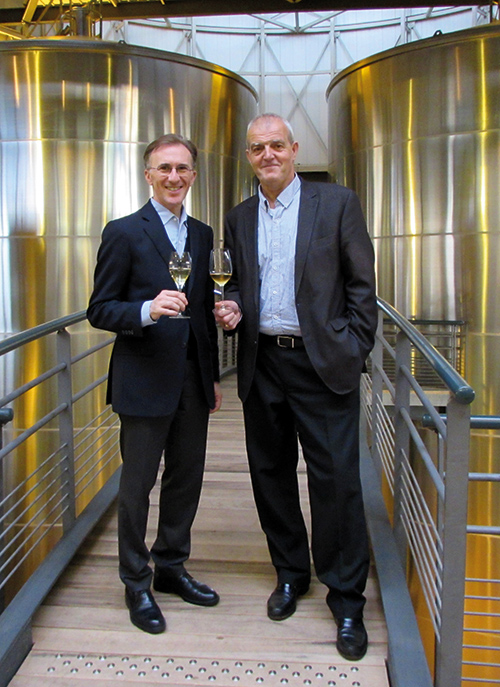
In the middle of the 90s, in the suburbs of Reims, a grain field has been replaced by a 15-ha top-notch industrial plant. An amphitheater of 200 gleaming thermoregulated stainless steel vats in use since 1995. Under ground, the cellars surrounded with the vathouse, the different areas of riddling, disgorgement, labelling, shipping … The ensemble is located on 15 hectares where is now centralized the entire production of Piper-Heidsieck. With, in 2008, the addition of the head offices, a modern building by architect Jacques Ferrier adorned with a metallic fishnet and golden panels … Piper-Heidsieck fully entered the 21st century. And this transformation is not only a facade.
“For 15 years, we diversified our supplies in the Côte des Bar area with Pinot Noir, the core variety in our blends. We also have separate vats for each cru and above all, we undertook a huge work on our reserve wines”, says Régis Camus, eight times elected “Chef of the Year” by the jury of the International Wine Challenge. “On our Brut, which is a puzzle rebuilt every year, we first seek the structure provided by the Pinot Noir, the fruitiness, the freshness, but also, which is more complex, the depth by adding 10 to 20% of reserve wine (50% Chardonnay – 50% Pinot Noir) aged for 6 years on average. It is the last piece of the puzzle to complete our non-vintage Brut”.
Willing to overcome “the image of the night and fashion, and give back the NV Brut a personality and a soul”, Régis Camus has polished a special cuvee for well-informed connoisseurs, ‘Essentiel Extra-Brut’. “It is a NV Brut with no frills, 16% reserve wines, 5 years ageing and a lower dosage of 5g instead of 9 usually in the NV Brut, to better taste the structure of the Pinot”. A necessarily more vivid cuvee which should “be accompanied by products that provide unctuousness to balance the straightforwardness” according Paolo Basso.
Then come the vintage Champagnes, “genuine pictures of the year” says Régis Camus who is unbeatable for all the weather conditions and harvests of the past decades: drought in 1976, the extreme cold at -30°C in 1985, the heat wave in 2003 … “De facto, each one has its personality, the 1996 is called the ‘fiery’, the 2004 the ‘marathoner’ because of its energy, the 2006 the ‘generous’, the 2008 the ‘virtuoso’, a very precise wine …”.
And an “extraordinary vintage, the 2002” that has given the 8th vintage Champagne of the range ‘Rare’, a blend of 70% Chardonnay and 30% Pinot Noir. “This one shows more tropical fruits–mango, kiwi, passionfruit …–a lot of minerality and is a cuvee that must be given time to express all its vividness”, describes Régis Camus, always in quest of exceptional sips to seduce the Upper Millennials.
Since the founding of the house in the 70s in Fontette, Senez has earnt its colours in the Aube region thanks to tenacity and simplicity.
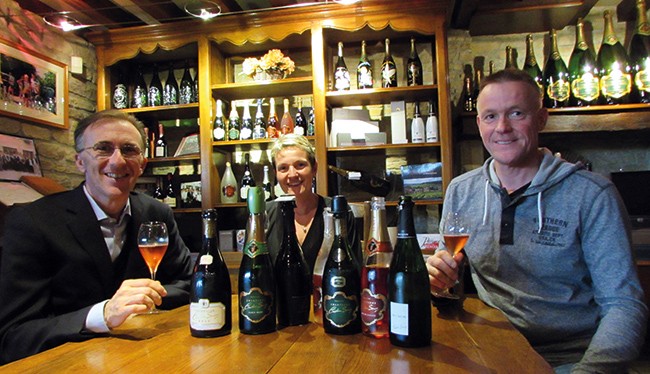
On the façade, a young Bacchus idly sitting on a barrel, the glass raised, invites the visitors straight away to enjoy some nectars. De facto. As soon as you cross the door, Angélique, the owner of the estate, takes glasses and puts them on the massive wooden table. “Do you want to taste right away?” does she say in a shy tone but with a generous smile. Here, at the Senez’s, no long speech nor storytelling, all is in the bottle, the product, the sincerity and the simplicity. On the table, the Brut ‘Carte Blanche’, a 100% Pinot Noir, their best-selling cuvee and produced by 260,000 bottles a year. “A polyvalent wine that will find its best expression at the aperitif”, comments Best Sommelier of the World Paolo Basso, underlining “its acidity that provides a lot of vividness on the palate”. Beside the house’s reference, they propose a wide range with ‘Carte Verte’, a half Pinot-half Chardonnay blend, bled rosés, Brut Nature, vintage Champagnes and even Coteaux Champenois wine and Ratafia.
“All our wines have been crafted without malolactic fermentation since 1988” explains with conviction Angelique’s husband Frédéric who is in charge of the vinification. “It is more demanding, but our wines can be kept longer and preserve more freshness”, he ads while specifying he makes them rounder by adding rectified concentrated grape must. “The grapes come from our 21 ha in Fontette and Essoyes. In order to produce a total of 414,000 bottles a year, we also buy grapes on 22 ha in the same area to be sure we keep the same quality” Frédéric continues. He took over the reins of this house 17 years ago when he married Angelique, Cristian Senez’s daughter, who loves to tell the story of the conquest of the family. “My father, who was the cellar master of the cooperative cellar of Fontette, started buying a few plots in the 50s then he started making his own cuvees in 1973 while buying several hectares. He is a builder.”
The Senez house has kept evidences of this obstinate family path. First the wooden tasting room and bay windows they built themselves and where hangs a picture of Cristian, fond of sports, with David Douillet. Then their shop in the South of France still managed by Cristian and Josette. “And if nowadays we sell 25% at export in Japan, Spain, Italy, Germany, Tahiti … it is particularly thanks to my parents who were really good, when they went on holidays abroad, in connecting and meeting people and find new markets”, Angélique underlines.
With a wealth of this family history, under the sign of union and transmission, Angélique and Frédéric have naturally crafted 4 years ago a special cuvee dedicated to their two daughters, now students, ‘La Cuvée des Filles’. A blend of half Chardonnay, half Pinot Blanc that stands out, according to Paolo Basso, “by its silvery shades, its aromas of golden apple, melon and redcurrant, its rich and moreish palate with a vivid freshness”. A vividness and youthful spirit present in all the cuvees crafted by the Senez who, pioneer in the region in the sales on internet, embodies more than ever a spirit of conquest.
Rare grape varieties like Pinot Blanc, a 100% Chardonnay at only 3 bars … Pierre Trichet, a wine growersettled in the village of Trois-Puits, at t he foothills of the Mountain of Reims, uses the past history to better create and surprise the palate.
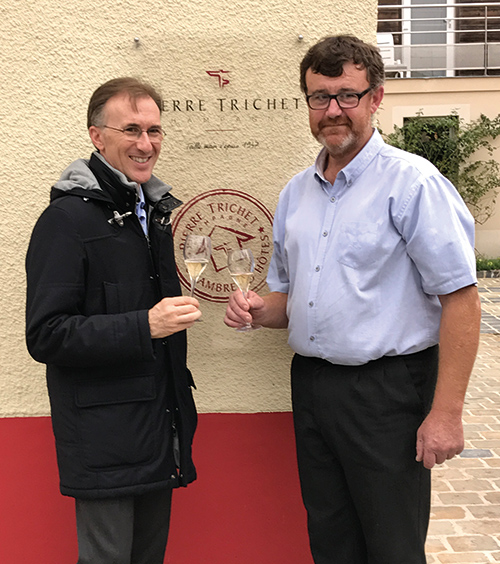
“Yes, it is true, he keeps on testing, searching, experimenting, it is in his nature,” his wife Mireille Trichet says. Under the vaults and in the freshness of his cellar dating back 1783, a labyrinth of 40 meters long under his house, Pierre Trichet, aged 50, works on his blends like an alchemist. “When I took over my parents’ estate in 1986 my father trusted me and let me do what I wanted. I had a listener and my hands free, a great luck,” he says with a grateful look at his father René.
His first creation launched in the 90s, the cuvee Caractère, a Blanc de Noirs Premier Cru, very fresh, with a delicious character, was a good bet. Now it represents 20% of his sales, especially with individuals. Attached to his land and to the history of the terroirs Pierre Trichet did it again, with an original cuvee, Secret d’or, released in 2015, a 100% Chardonnay with a peculiarity: “I bottle it with 3 and not 6 bars of pressure to find back the features of ancient Champagnes, a ‘demi-mousse’ wine [less sparkling], not vivid nor tangy, but with a dosage of 7 or 8g, not 12 like in my parents’ time”. Coming back to the trends of the 60-70s the wine grower with the stubby hands of those who work the land even revived Chardonnay still wines he marketed in autumn this year. “It is a would-be Champagne, I was thinking about it for long, I thought it was a pity that the region had lost these wines.”
But his quest also leads him to search for rare varietals. Pinot Blanc that he rediscovered a few years ago when tasting still wines in Aube completely seduced him. “I planted some, to remain prudent, on a small plot in Premier Cru, willing to create again the wines that could be enjoyed in Dom Perignon’s time”. Just released, his 100% Pinot Blanc cuvee ‘1333’–a name indicating the confidential number of bottles produced and all numbered–opens up with aromas of spices and white-fleshed fruits, followed by beautiful flavours of white pepper and citrus. Something original. “To us, it is different from Chardonnays and Pinots. We don’t know if it is a Blanc, a Noir, we don’t know how long it will keep, if we can improve it … It is the beginning of the story,” says the tireless explorer with a sparkle in his eyes.
The Paul Bara estate dates back 1833 and sales Champagne since the 50s. With 11 hectares in the Grand Cru area of Bouzy and a plot of land in Ambonnay, the house works with 85% of Pinot Noir in which Chardonnay plays a moderating role. The king is Pinot Noir, many cuvees are dedicated to this varietal, in this house where Champagne is first a wine.
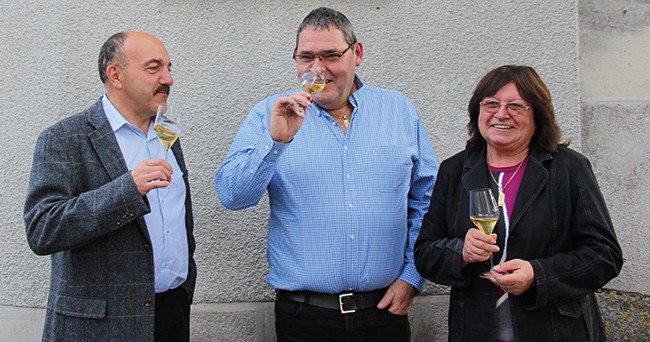
In Bouzy, kingdom of Pinot Noir, the Paul Bara house has been handed over from generation to generation for 170 years. It pro–duces 100,000 bottles of 7 different Champagnes as well as a red wine: red Bouzy. With Chantale Bara, who took over the reins in 1986, the style gained precision and aromatic distinction. While respecting the great family traditions Chantale has found her own style by the work of the soils that are ploughed and covered with grass, and the renovation of the vathouse to reach her objectives in terms of quality improvement. The Paul Bara Champagnes are now sold by 70% over the 5 continents in 30 different countries.
In the cellars, Christian Forget, the demanding and passionate cellar master, respects uncompromising rules but admits he leaves pride of place to intuition, which gives an extra soul to the family’s sparklings. Because it is through the cult of the diversity of its terroirs that the house has rooted its reputation and draws the excellent complexity of its wines. In order to preserve the original character and freshness of the wine, the house stopped the malolactic fermentation since 1996 because it reduces the terroir effect and the ageing potential. Here the Champagnes age for a long time in the quietness and depth of the century-old cellars dug in the chalk. The house is appreciated for its old vintages.
And when Chantale Bara is asked to describe the house’s signa–ture, “powerfulness, generosity, straightforwardness” are the three words that come to her mind. A signature marked by the house’s loyalty to the varietal whose white juice they managed to tame, the Pinot Noir that is said to be so masculine. “In 2016 we launched a new cuvée, a tribute to our ancestors, ‘Annonciade’, my forebear who married the first Bara arrived in Bouzy. Another cuvee, ‘Comtesse Marie de France’ stems from 60-year-old vines with 100% Pinot Noir” Chantale specifies. “The aromatic range of this cuvee displays candied cherry, blackberry tart as well as hints of mild spices” Gerard Basset comments when visiting the domain and ads, “the notes of candied mandarin would perfectly match a seabream with olives”.
Alexandre Cornot made a noteworthy entrance into the Champagne houses’ universe. Among great brands and independant wine growers, the negociant imposed his own style. At his image, peculiar, exuberant, unconventional.
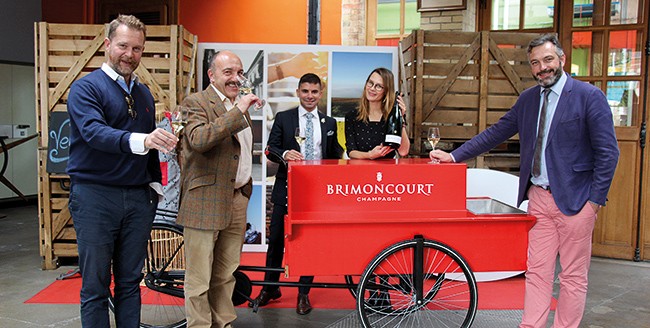
With his old school Oscar Wilde dandy style, wearing a Belle Epoque handlebar moustache and a pair of preppy orange socks, Alexandre could have been the main character of one of Agatha Christie’s books. But he is not. Promoting luxury à la française, he chose to create a Champagne with a giraffe in a military uniform on the escutcheon and, as the figurehead, Philippe d’Orléans, young Louis XV’s regent, who is said to be the one who introduced Champagne into the royal court. His brand? Brimoncourt, a name he purchased, free from any history, to which he gave a kind of Regency spirit and an epicurean motto: lightness, sharing, elegance and independance.
Nothing meant him to become a Champagne negociant but his origins in Reims. Successively naval officer, double graduate in tax and business law, solicitor in Paris, art dealer in New York, Alexandre came back to Champagne in 2007 when he bought from one of his friends the Edouard Plantet printing office in Ay with 8,000 lithographic stones of old Champagne labels. It became Brimoncourt’s headquarters, a brand that has been dormant for such a long time that everything had to be re-created.
Alexandre then crisscrossed the vineyard to find supplies and build up the identity of his house. Then six years of a long ‘underground’ work followed during which the entrepreneur found partners and injected 7 million euros to structure the house.
Brimoncourt has been launched on the market in 2013 with a Brut, called ‘Régence’. Then came a Blanc de Blancs and a Rosé in 2014, then an Extra-Brut dosed at 2g crafted with 80% Pinot Noir and 20% Chardonnay. In 2018 the range will be added a 2009 vintage cuvee.
The packaging is elegant, the quality of the wines has soon been praised by the media. “A complex nose with nectarine, dried fruits and ginger with mentholated notes, and loads of freshness on the palate”, Gérard Basset commented about the Extra Brut. The brand targets the wine shops, starred restaurants and a public of epicureans, “a universe of pleasure, free-spirited, offbeat” with peculiar partners like hunt clubs, car circuits, the Tuileries gardens, the Cannes Film Festival … that compose a kind of “relaxed galaxy”. His projects? To purchase vineyards to secure his supplies and to open export markets.
The Langlet Champagnes are an original adventure, that of three friends, native from wine grower families of Champagne, who decided to create a brand at their image. Epicurean, festive, authentic. With the emblem of a donkey, not Perrault’s one but the one of the fortunate coincidences …
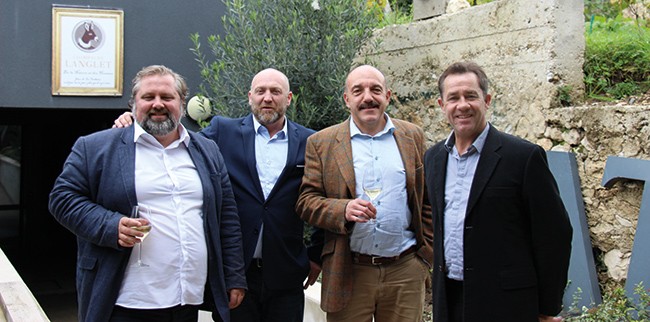
You have Vincent Métivier, the man in the vineyard, the horse whisperer, who continuously studies his land, not yet organically farmed but with a permanent concern for nature (integrated farming, limited treatments, grass cover between the rows …); Luc Chaudon who runs a trade house whose vineyard in the Moutain of Reims mainly consist of Grand Crus and First Crus; and Frédéric Papelard, ambassador of the brand, to who we owe to find Champagne Langlet on many fine tables in Paris.
They needed a name, they chose Langlet, Vincent’s mother’s maiden name, in tribute to her passing away too early, in hommage also to the three winegrowers’ roots in Champagne. They needed a history and an emblem. They chose the legend of the donkey Martin that is said to have invented pruning. The story says that during a tour in the monasteries in the winter, Martin de Tours fell asleep in a vineyard after having tied his donkey to a post. The latter grazed the vine shoots, stirring up the monks’ anger against the donkey’s greedy foolishness. But when the time of harvest arrived, they had a beautiful surprise. Fleshy and savoury bunches of grapes were hanging on these same vine stocks. The donkey, renamed Martin, is since then printed on the bottles of Langlet …
“Moreish, natural, terroir driven wines, dedicated to all fortunate coincidences …” At Langlet, the brand is placed under the sign of the malicious cooperation of destiny. That is what the three musketeers wished, partisan of the ‘one for all and all for one’ spirit. “When one feels low, the others bring up his spirits” says Frédéric who is in charge of the sales and communication, driving around in his London black cab. “Today I supply some 400 restaurants in Paris. It is a very competitive market, loyalty is not the rule anymore, we have to be present and serious. We tried exports but we turned back. Now we are ready, we are looking for importers.” The range comprises 7 cuvées with a total of 60,000 bottles, from the house’s Brut with its notes of plum and wild cherry to the Extra Brut aged in oak barrels “with aromas of roasted pine nuts and lavender honey in the finish”, to be served over “an oven-baked lamb loin with rosemary” according to Best Sommelier of the World Gerard Basset. In brief, Champagnes that dread no challenge, as long as pleasure is the only challenge, as evidenced by the huge kitchen in the middle of the cellars of Champagne Langlet.
“Truth is in the glass” … Is it in order to validate the saying that Jérôme Legras tattoed a Venitian glass on his arm? However he has his profession under his skin and the taste for authentic and pure Champagnes that speak about their roots and are able to match any delicacy on the table. Beside his parents and his two brothers, he defends the house that bears his name, Legras & Haas.
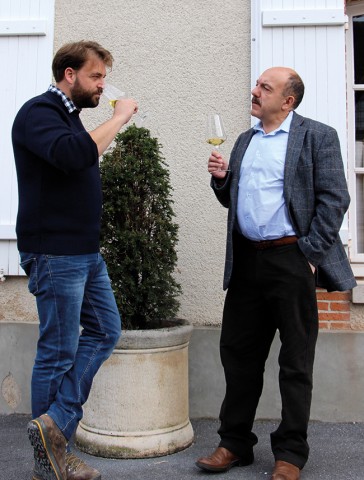
What is the identity of the family’s Champagnes?
Our house has been existing since 1991. It is a classical family house, that produces great Champagne products with a range of 7 cuvees that all have a low dosage (0 to 8 g/l) which enables to preserve the elegance and purity of all our cuvees. But the signature of our brand is the Blanc de Blancs Grand Cru from the terroir of Chouilly where we have 17 hectares. In a universe where a lot try to impose their style and create a sometimes artificial identity, I think our wines are refreshing by their assumed classicism. Our viticultural practices evolve with the will to give pleasure and have pleasure as wine growers. That is why in a parallel to integrated farming, we have some plots where we are trying organic farming.
At Legras & Haas, we try to let the fruit and wine “sing in tune”. It is our motto, we seek elegance with sobriety, finesse with rigor, various criteria that challenge every year our Champagnes!
Do you have projects?
The goal of the house is to continue the tradition of crafting great Blanc de Blancs with our terroir. The idea is to develop quite naturally, without too much communication, nearly just thanks to the quality of our wines. Our latest cuvees include a plot-selected cuvee, stemming from the terroir of Chouilly, not known enough according to us, and a 100% Chardonnay from Chouilly crafted only in a solera since 1995–this wine is currently still ageing. We also have interesting biases with our vintage Champagnes with a 2007, a 2011, a 2013 and we will even make a bit of 2017. It is an interesting choice that will hopefully interest the curious Champagne lovers.
Where the Legras & Haas Champagnes sold?
They are sold in 25 countries, and the house sales 85% at export with a big part in Germany, Sweden, Italy … with a big proportion of magnums. We are very present in the restaurants. In the wine world, Champagne is the only beverage that can claim to accompany the important moments of life by giving them instantaneously another dimension. Through its history Champagne managed to communicate about these festive moments. This reputation is now certain, we have to evolve without denying these values and bring it into the gastronomy especially. Consumption nowadays is more accurate, people are interested in dosage, in the impact of the vintage, in the pairings with food … One does not drink Champagne; one chooses a bottle with its history, its author. That is why it is important to open our houses, and that is what we do to share our passion.
The Perard family, ploughers and wine growers since 1662, opened the book of their history again to write new pages. ‘Diadème’ is the title of this new chapter. A Blanc de Noirs whose name in greek means “what surrounds”, a punchy and round wine …
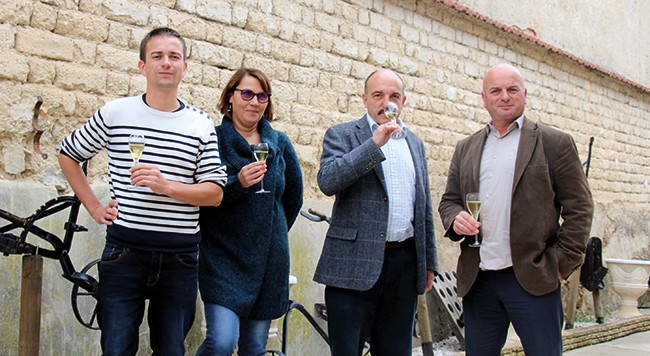
Here the 9 hectares produce 9 cuvees with the 2 iconic varietals of the appellation Pinot Noir and Chardonnay, mainly from the Grand Cru Ambonnay area in the Marne department. Patrick Pérard who took over the family estate in 1996 works his land with passion, picking the best of each technique: grass cover to avoid erosion, excessive azote and limit botrytis, grass mowers, hydraulic ploughs, hedges to favour biodiversity, new approaches to revive the terroir … the work of the vineyard meets the issues of environment and earth respect.
Without forgetting to respect the customer which starts by making themselves available: “We have very loyal customers, some knew my grandfather, we now welcome the children of our customers … Our network works by word of mouth and we welcome a lot at the estate ; our distribution channel remains quite familial. We sale 50,000 bottles and have approx. 2,000 active customers (wine shops, workers' committees, individuals) with 60% in Belgium. But we would like to develop overseas export to diversify our sales,” Patrick Pérard explains.
In this spirit, they created the Diadème cuvee crafted only with Pinot Noir from Ambonnay, very lightly dosed to not overwhelm its nature. A name that can be, according to the dictionaries, a sign of royalty, a princess jewel, the name of a butterfly or of an urchin.
But above all Diadème represents for the family a new desire to mark their history. “We have started to invest in a little vathouse to develop one or two cuvees with my son Virgile who helps from the production of the grapes until the crafting of the Champagne. This will help us give a new personality to our range, and to be know differently, especially on export markets. Diadème is the beginning of a new chapter in our history.”
It is the latest creation of the Veuve Clicquot house. The great iconic house rides the trend of low dosages. It strangely took the time to develop its Extra Brut, Extra Old, presented as “a concentrate of Carte Jaune”, the House’s Brut. Interview of Philippe Thieffry, the enologist.
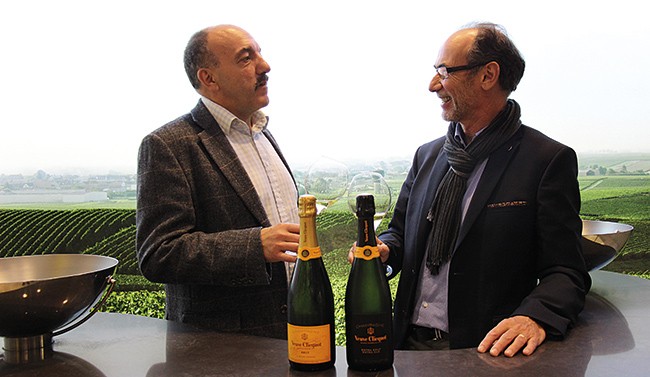
What is the history of this new cuvée?
This new cuvee draws its roots from the history of the wines of the house established in 1772. To date, Veuve Clicquot has one of the most beautiful collections of 20 years of reserve wines, from 1988 to 2017. It is unique in Champagne. We have more than 400 reserve wines. These “reservists” have one of the most fundamental roles and provide depth, complexity and silkiness to our mid-range cuvee, ‘Carte Jaune’, emblem of Veuve Clicquot that represents 90% of our sales. We decided to use these treasures to show our savoir-faire in the élevage of our reserve wines. We also wished to create a very low dosed wine, something new to Veuve Clicquot.
What is the secret of its composition?
It is made of six years of reserve wines among which the most precious of the collection: 2010 (a vivid year), 2009 (a year of plenitude), 2008 (minerality, powerfulness, purity), 2006 (a solar vintage), 1996 (the vintage of the millennium) and 1988 (balance). Of course, it is a sophisticated wine that “clicquoes”, creamier, vanilla-scented, complemented with purity. It is haute couture, it has not been improvised. We worked with test tubes with some 20 wines. This blend allows a very low dosage of 3g.
Who is it made for?
Extra Brut, Extra Old is a drop in the Veuve Clicquot universe in terms of quantity. It has been created, targeted, with its black and elegant packaging, to become the ambassador of Carte Jaune, its very essence. Its distribution is selective: top gastronomy, greatest wine shops. We imagined this wine to be served as much for the aperitif as over a meal, with calf sweetbread en croute for example.
Fifth generation of wine growers, rooted in the terroir where he was born, owner/grower Olivier Suply runs the family estate in Vrigny in the Marne department.

Careful selection of the grapes, respect of the terroir, horses for ploughing to compact the soils less, this is the spirit that characterizes Suply, partisan of ‘fair’ wine, to farm their 5 hectares of vineyards among the 160 hectares used to grow cereals, barley, wheat, beetroots …
But a vineyard is not enough to make grapes sparkle, otherwise all bunches would. You need the right conditions. Olivier Suply, a dynamic wine grower, finds them at the cooperative cellar of the village who is the treasurer of, that does not produce bottles but that enables each member to have at his disposal modern tools from pressing to bottling through vinification and even to buy his own barrels to make his own Champagne. “We sell half of our grapes by the kilo and work the other half.” 20,000 bottles classed First Cru are thus signed by the house in a range of 5 Champagnes, with a new one to come in 2018, a Blanc de Blancs aged in oak barrels. “Our range is sold through big national structures and the rest to individuals.”
By the way the house started wine tourism with a guesthouse hosting several tastefully decorated rooms to welcome their customers: 70% of them come to buy directly at the estate. “The notion of sharing is crucial to us, as much with the cooperative members as with the customers we welcome at the estate all year long,” Olivier Suply says.
Marianne Peyri
Since 1885 the Vesselle family has been growing vines and making Champagne wines on the terroir of Bouzy, classed 100% Grand Cru on the southern slope of the Mountain of Reims. In 1979, Alain Vesselle handed over a family savoir-faire to his son Eloi Vesselle. For 4 years Guillaume Vesselle, one of Alain Vesselle’s grandsons, took over the reins of the family company.
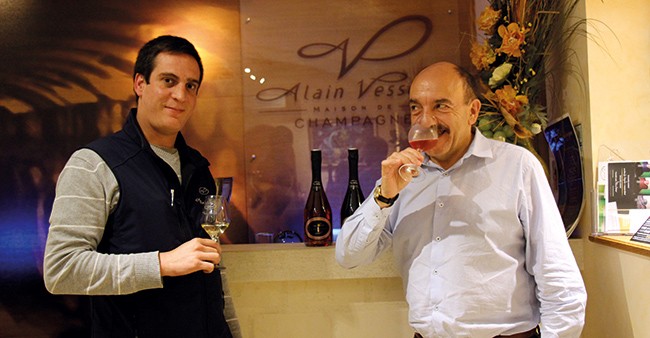
Guillaume is the oldest of a sibship of three boys. Being the oldest of a lineage of wine growers means being the unquestionable guarantor of the continued existence of a name, a brand, a profession … Guillaume grew up with a family savoir-faire. His two brothers are finishing their studies: marketing for Antoine and wine tourism for Thibaud.
Guillaume started by restructuring the visual identity of the labels and would like to develop his Saint Eloi range for 2020 and turn towards export.
“With our 18 hectares of vines, we produce 80,000 bottles, the rest is for the trade. I sell 95% of the production to a clientele of individuals in France and Belgium. It is a loyal clientele through several generations. Now, the grandchildren of my grandfather Alain Vesselle’s customers come to buy our Champagne. It is rewarding! In the upcoming years I would like to develop exports.”
Bénédicte Chapard